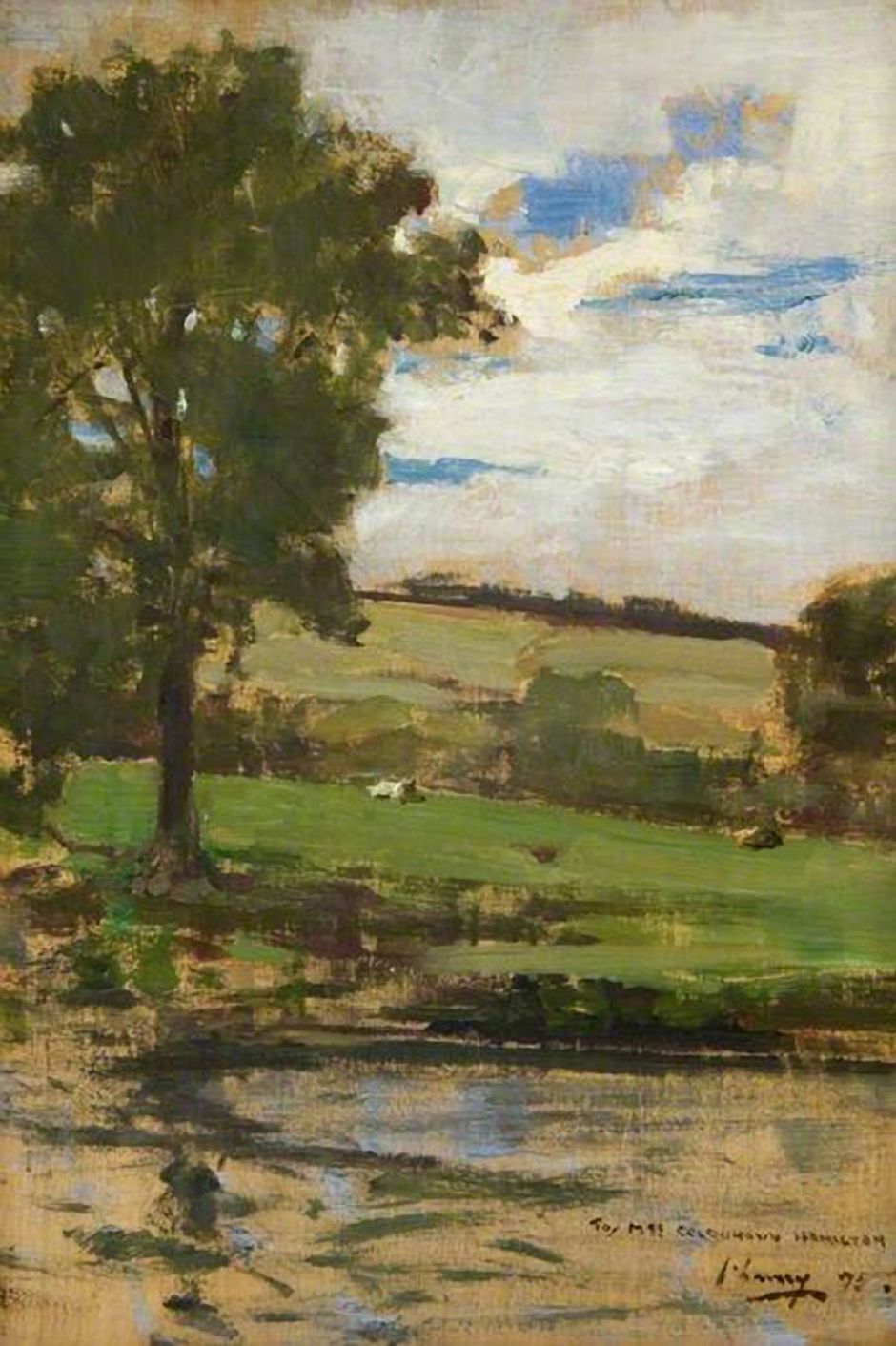One of the many painters who returned from training in France during the 1880s was Irish by birth and had been living in Scotland. Nevertheless, he made much of his career working in England: he is Sir John Lavery (1856-1941).
Lavery was born in Belfast, but moved to Glasgow when he was a child. After initially attending the Haldane Academy in Glasgow, he went to Paris in the early 1880s, where he was a student at the Académie Julian. There he was initially influenced by the Naturalist works of Jules Bastien-Lepage and Millet, and painted at Grez-sur-Loing in 1884.

Lavery’s plein air oil sketch of The Principal Street at Grez from 1884 shows one of the many artists at work in the village, which had become internationally popular at the time. Although following the course recommended for Naturalist painters, Lavery’s style is here thoroughly Impressionist.
He returned from there to be one of the Glasgow School (as one of the Glasgow Boys).*

While working in Glasgow, he painted a series of views of tennis games and players, including The Tennis Party, from 1885. This follows the approach adopted by Naturalists such as Bastien-Lepage, in being quite loose in the surrounds, but delivering fine detail in the figures and nearby. That includes the tennis players themselves, and the wire netting surrounding the court.
Lavery’s major break came in 1888, when he was commissioned to paint the state visit of Queen Victoria to the Glasgow International Exhibition in Kelvingrove Park that year. Following that success he was in demand as a portrait painter to the rich and famous, so moved to London, where he joined Whistler’s circle.

By about 1890, when he painted Boating on the Thames, his style in landscapes had become more realist, although the trees in the distance still lack detail or precision. This scene is thought to have been at Marble Hill (House), Twickenham, London, or by the steps beneath Cliveden House, Taplow, Buckinghamshire. Chinese and Japanese influences in clothing and the parasol were all the rage at the time, and are seen in some of Whistler’s paintings.
Late in the century Lavery started travelling to North Africa, where he fell in love with Tangier, a city on the northern coast of Morocco opposite Gibraltar, and bought a property there by 1903. In 1906, he travelled to Fez to paint, and in 1908 had a solo exhibition at the Goupil Gallery in London.

A Southern Sea (1910) may be a view across the Strait of Gibraltar, which could be the prominent peak on the horizon. Although other paintings of his from the early twentieth century had become much tighter, the clouds here are particularly painterly.
During the First World War, Lavery was an official war artist, but was injured fairly early, and mainly painted scenes of industry in the UK. For those he returned to realism and fine detail, and his loose brushwork didn’t return until after he had painted the formal surrender of the German High Seas Fleet in November 1918.

Tangier Bay, Sunshine (1920) is more obviously a view from Tangier Bay looking north across the Strait of Gibraltar, which is seen in the clear above the end of the small jetty at the left. This appears to have been sketched in oils in front of the motif.
Although there are many of Lavery’s paintings accessible now, few have any information, even a title and year. Four relevant landscapes for which I have been unable to find any further information are:

This oil sketch shows a pond in parkland, and bears the dedication “To Mrs Colquhoun Hamilton”, and may be dated 1895.

This landscape with trees in blossom was almost certainly painted in Morocco, judging by the dress of the two figures.

This is a different view of trees in blossom. On the other side of the lake is a group of half a dozen figures.

Southampton Water is undated, and shows the industrial waterfront of Southampton, on the south coast of England. This appears to be another quick and loose painting made in front of the motif.
There can be little doubt that John Lavery was one of the British Impressionists, and that he retained the style from around 1884 until well into the twentieth century.
* I am grateful to Robert for pointing out that the term Glasgow School may be unfamiliar. It’s intended as a more inclusive reference than the better-known Glasgow Boys, which explicitly excludes the women artists who are also known as the Glasgow Girls. See Wikipedia for further details.

